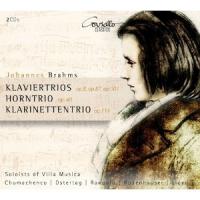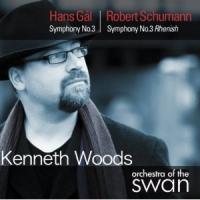Classical CDs Weekly: Brahms, Gál, Holliger, Schumann | reviews, news & interviews
Classical CDs Weekly: Brahms, Gál, Holliger, Schumann
Classical CDs Weekly: Brahms, Gál, Holliger, Schumann
German chamber music, Swiss modernism and Viennese classics
Brahms composed trios throughout his life - these well-loved pieces contrast with the much rarer works of Hans Gal and the oboist Heinz Holliger, here exposed in his parallel career as a composer.
 Brahms Piano Trios, Horn Trio, Clarinet Trio Soloists of Villa Musica (Covellio Classics)
Brahms Piano Trios, Horn Trio, Clarinet Trio Soloists of Villa Musica (Covellio Classics)
Brahms’s B Major Piano Trio was originally composed in 1859 but was drastically revised and republished in 1889. Writing to his publisher about the later version, the one generally played today, Brahms felt that “although the old version is bad, I do not maintain that the new one is good!” It’s a fascinating mixture of early and late styles – more expansive than mature Brahms, though transition passages and developments feel like the work of an older, wiser composer. More consistent is the Second, C Major Trio – tautly assembled in the outer movements with a brilliant, Hungarian-inflected Andante. The Third Trio is a good example of Brahms in grumpier, gruffer mode; it’s the tersest, most compact of the set.
They’re given here in reassuringly direct, unfussy performances by an ensemble associated with the Villa Musica Foundation, a state-funded German body providing chamber music tuition for gifted students. Estonian pianist Kalle Randalu is calmly responsive, matched by Nicholas Chumachenco and Martin Osertag on violin and cello, the three playing with no hint of flashiness or ego. We also get a lovely performance of the early Horn Trio, in which the soloist is the British virtuoso Frank Lloyd – one-time member of the Philip Jones Brass Ensemble and now resident in Germany. His darker, bolder sound makes the work feel more autumnal than Sarah Willis’s more youthful, lyrical reading.
The highlight for me is the inclusion of the sublime 1891 Clarinet Trio – perfect, "late" music – world-weary, melodically rich and quietly ecstatic, despite the music's minor key. Ulf Rodenhäuser, one-time principal clarinet of the Berlin Philharmonic, is a warm, velvet-toned soloist.
 Hans Gál – Symphony no 3, Schumann – Symphony no 3 Orchestra of the Swan/Kenneth Woods (Avie)
Hans Gál – Symphony no 3, Schumann – Symphony no 3 Orchestra of the Swan/Kenneth Woods (Avie)
Avie continue their Hans Gál symphony revival with another disc pairing his music with an established Austro-German work. Born in Austria in 1890, Gál enjoyed a successful compositional and academic career in Germany before fleeing to Britain in 1939, eventually obtaining a post at Edinburgh University. His Third Symphony was completed in 1952 and has lain dormant for 55 years. Hopelessly anachronistic, it glances wistfully back at the world which Gál had left behind; the music of an exotic emigré marooned in rainy post-war Edinburgh.
Gál’s impassioned, well-crafted late romanticism is readily accessible and quietly moving - there’s a lot to enjoy here. He’s good at subtle transitions – the way that the delicious opening melody segues into the first movement’s more agitated fast section, and its brilliant, ghostly close. Only the Finale left me baffled, with a stentorian opening quickly yielding to a triumphant ending which feels a little too easily achieved. It’s nicely played by Stratford-upon-Avon’s Orchestra of the Swan under Kenneth Woods, who are up against stiffer, famous-name competition in Schumann’s Rhenish Symphony.
In this brilliant, exuberant work, Woods takes full advantage of his orchestra’s modest size, choosing swift speeds and enjoying well-articulated string playing. The Scherzo has an appealing village band feel, and Wood’s trombones in the stark contrapuntal fourth movement are faultless. The same material’s major key reprise in the last movement is a great moment, prefiguring the brassy chorales heard at the end of Brahms’s First and Mahler’s Fifth. It’s a good performance. Gál may be a hard sell, but his listener-friendly, bittersweet music deserves an outing, and the Schumann symphony is an attractive bonus.
 Heinz Holliger: Induuchlen (ECM)
Heinz Holliger: Induuchlen (ECM)
More extraordinary sounds from the septagenarian Swiss oboe virtuoso, here heard in his parallel career as a composer. The mind boggles at how anyone can possess the aural imagination to summon up sounds such as those heard on this disc. This is not easy listening, but neither is it especially difficult. Holliger’s sounds always feels like music, and he has a brilliant aptitude for understanding what individual instruments can do best. You hear this in the brief set of Toronto-Exercises which open the disc – four tiny, brittle studies for a quintet dominated by breathy, percussive flute sounds. The CD closes with 2002’s Ma’mounia, a 12-minute mini-percussion concerto, with soloist Matthias Würch gamely pitting flexatone and a range of other exotic timbres against a tiny chamber ensemble.
The ensemble includes Oliver Darbellay, whose playing on the natural horn features in the most striking work on the CD, Holliger’s song cycle Induuchlen, a setting for horn and countertenor of poetry by the Swiss writer Albert Streich, whose texts were composed in Swiss dialect (alas, untranslated in ECM’s otherwise exemplary notes). Darbellay sings, hums and breathes through his instrument, and countertenor Kai Wessel is forced to descend deep into his lower register. The horn’s valveless harmonics have a unique, otherwordly feel – the same weirdness that Britten tapped into in the prologue to his Serenade. The inclusion of a 1958 tape of Streich reading his poetry is a nice touch. The other big work is Holliger’s Puneigä, a 10-movement cycle using poems by Anna Maria Bacher, again using a Swiss dialect. Soprano Sylvia Nopper sings over a shimmering, fragmentary septet accompaniment to disquieting effect. Holliger conducts the Swiss Chamber soloists, and makes the whole thing sound as logical and effortless as the baroque repertoire in which he excels as a player.
Share this article
The future of Arts Journalism
You can stop theartsdesk.com closing!
We urgently need financing to survive. Our fundraising drive has thus far raised £33,000 but we need to reach £100,000 or we will be forced to close. Please contribute here: https://gofund.me/c3f6033d
And if you can forward this information to anyone who might assist, we’d be grateful.

Subscribe to theartsdesk.com
Thank you for continuing to read our work on theartsdesk.com. For unlimited access to every article in its entirety, including our archive of more than 15,000 pieces, we're asking for £5 per month or £40 per year. We feel it's a very good deal, and hope you do too.
To take a subscription now simply click here.
And if you're looking for that extra gift for a friend or family member, why not treat them to a theartsdesk.com gift subscription?
more Classical music
 Connolly, BBC Philharmonic, Paterson, Bridgewater Hall, Manchester review - a journey through French splendours
Magic in lesser-known works of Duruflé and Chausson
Connolly, BBC Philharmonic, Paterson, Bridgewater Hall, Manchester review - a journey through French splendours
Magic in lesser-known works of Duruflé and Chausson
 Tales of Apollo and Hercules, Guthrie, London Handel Festival, Shoreditch Town Hall review - compelling elements, but a failed experiment
Conceptually the two cantatas just doesn't work together
Tales of Apollo and Hercules, Guthrie, London Handel Festival, Shoreditch Town Hall review - compelling elements, but a failed experiment
Conceptually the two cantatas just doesn't work together
 Biss, National Symphony Orchestra, Kuokman, NCH Dublin review - full house goes wild for vivid epics
Passionate and precise playing of Brahms and Berlioz under a dancing master
Biss, National Symphony Orchestra, Kuokman, NCH Dublin review - full house goes wild for vivid epics
Passionate and precise playing of Brahms and Berlioz under a dancing master
 Verdi Requiem, Philharmonia, Muti, RFH review - new sparks from an old flame
Discoveries on a veteran maestro's epic journey
Verdi Requiem, Philharmonia, Muti, RFH review - new sparks from an old flame
Discoveries on a veteran maestro's epic journey
 Batsashvili, Hallé, Wong, Bridgewater Hall, Manchester review - a star in the piano universe
The Georgian pianist brings precision and freedom to Liszt’s warhorses
Batsashvili, Hallé, Wong, Bridgewater Hall, Manchester review - a star in the piano universe
The Georgian pianist brings precision and freedom to Liszt’s warhorses
 Naumov, SCO, Egarr, Queen's Hall, Edinburgh review - orchestral magic rescues some punishing music
Hard-driven Beethoven, monotonous Eötvös, some light from Kernis
Naumov, SCO, Egarr, Queen's Hall, Edinburgh review - orchestral magic rescues some punishing music
Hard-driven Beethoven, monotonous Eötvös, some light from Kernis
 Classical CDs: Shipping lines, sabre dances and sea lice
Neglected piano concertos, Italian art songs and new music for trombones
Classical CDs: Shipping lines, sabre dances and sea lice
Neglected piano concertos, Italian art songs and new music for trombones
 Il trionfo del Tempo e del Disinganno, Irish Baroque Orchestra, Whelan, St George’s Hanover Square review - Handel’s journey of a soul
Pleasure gets the best deal despite Beauty’s struggle to higher things
Il trionfo del Tempo e del Disinganno, Irish Baroque Orchestra, Whelan, St George’s Hanover Square review - Handel’s journey of a soul
Pleasure gets the best deal despite Beauty’s struggle to higher things
 Uproar, Rafferty, Royal Welsh College, Cardiff review - colourful new inventions inspired by Ligeti
Unfussy professionalism from Wales-based new music ensemble
Uproar, Rafferty, Royal Welsh College, Cardiff review - colourful new inventions inspired by Ligeti
Unfussy professionalism from Wales-based new music ensemble
 Attacca Quartet, Kings Place review - bridging the centuries in sound
Grammy-winning quartet bring more American punch than Gallic je-ne-sais-quoi to Ravel
Attacca Quartet, Kings Place review - bridging the centuries in sound
Grammy-winning quartet bring more American punch than Gallic je-ne-sais-quoi to Ravel
 Manchester Collective, RNCM review - exploring new territory
The string quartet – plus percussion and electronics – goes on a journey
Manchester Collective, RNCM review - exploring new territory
The string quartet – plus percussion and electronics – goes on a journey

Add comment